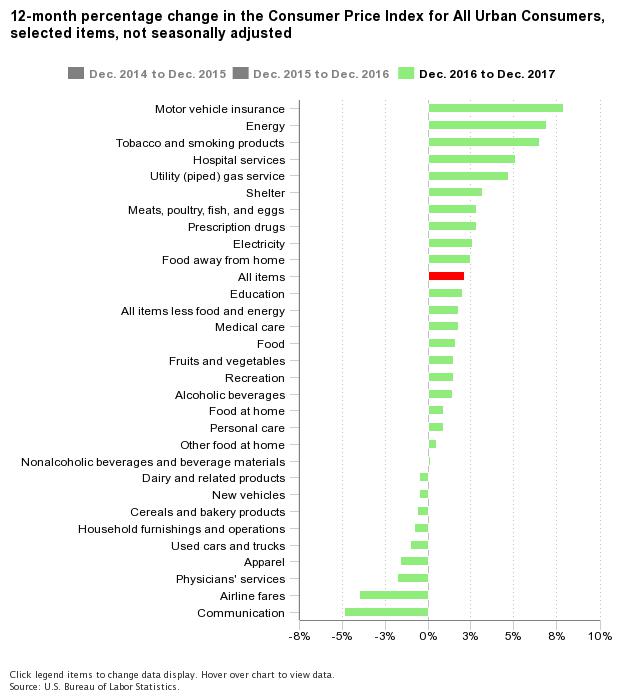Consumer Price Index: 2017 in Review
From December 2016 to December 2017, the Consumer Price Index for All Urban Consumers (CPI-U) rose 2.1 percent. Over the same 12-month period the previous year, the index also increased 2.1 percent, following a 0.7-percent increase from December 2014 to December 2015.
The food index increased 1.6 percent from December 2016 to December 2017. Over the same period a year earlier, the food index declined 0.2 percent. The index for food at home rose 0.9 percent over the December 2016–December 2017 period, after falling over the same period the previous year.
From December 2016 to December 2017, three of the six major grocery store food group indexes increased, two declined, and one was unchanged. Over that period, the index for meats, poultry, fish, and eggs increased 2.8 percent, after declining over the same period in 2015 and 2016. From December 2016 to December 2017, the index for fruits and vegetables rose 1.5 percent, after falling 2.4 percent over the same period in 2016. The index for other food at home increased 0.5 percent over the year ending December 2017.
The index for cereals and bakery products fell 0.6 percent from December 2016 to December 2017, similar to a 0.7-percent decline over the same period the previous year. The index for dairy and related products fell 0.5 percent from December 2016 to December 2017, its third consecutive yearly decrease. The index for nonalcoholic beverages was unchanged over the year ending December 2017, after falling over the same period in 2016.
Over the year ending December 2017, the energy index rose 6.9 percent, after a 5.4-percent increase over the same period in 2016. The gasoline index increased 10.7 percent from December 2016 to December 2017, following a 9.1-percent increase over the same period a year earlier. In December 2017, the index for natural gas increased for the second straight year, rising 4.7 percent, after increasing 7.8 percent from December 2016 to December 2017. Over the year ending December 2017, the electricity index increased 2.6 percent after rising 0.7 percent over the same period the previous year.
The medical care index increased 1.8 percent from December 2016 to December 2017, a substantial deceleration from its 4.1-percent increase over the same period a year earlier. From December 2016 to December 2017, the index for prescription drugs rose 2.8 percent, hospital services rose 5.1 percent, and the physicians' services index declined 1.8 percent.
These data are from the Consumer Price Index program and are not seasonally adjusted. For more information, see "Consumer Price Index — December 2017" (HTML) (PDF). Also see Charts related to the latest "U.S. Consumer Price Index" news release.





